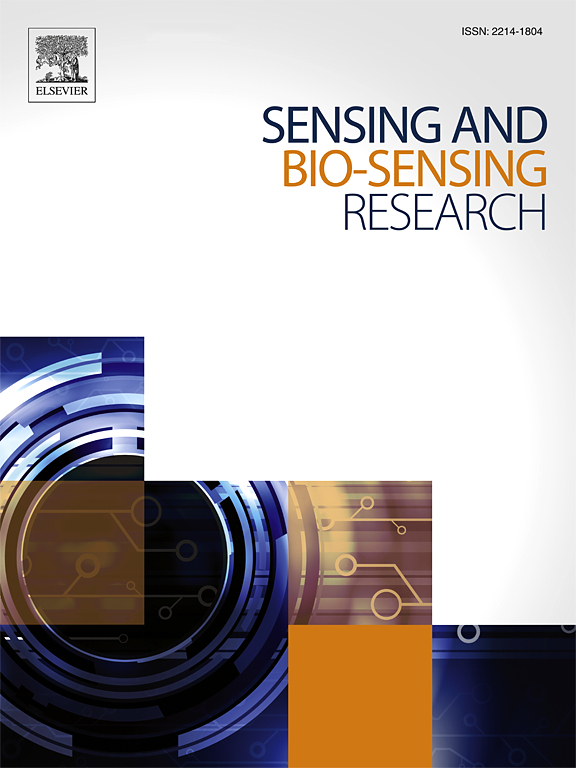Innovative polymer-based electrochemical platform for detecting ESAT-6 in human blood for pulmonary tuberculosis diagnosis
IF 4.9
Q1 CHEMISTRY, ANALYTICAL
引用次数: 0
Abstract
Pulmonary tuberculosis (TB), caused by Mycobacterium tuberculosis (Mtb), necessitates early diagnosis for effective patient care. Despite advancements in TB diagnostics, there remains an urgent need to discover innovative non-sputum-based methods to detect Mtb-specific antigens for TB patient identification. We have developed a polymer-based electrochemical biosensor for detecting an Mtb-specific antigen, the 6-kDa early secreted antigenic target (ESAT-6), in blood. Using a gold electrode (Au), the biosensor is created by electropolymerizing poly(3,4-ethylene dioxythiophene) with carboxyl groups (PEDOT-COOH), which is activated with 3-ethylcarbodiimide hydrochloride and N-hydroxysuccinimide (EDC-NHS), conjugated with an ESAT-6 polyclonal antibody (Ab), treated with bovine serum albumin (BSA) to block non-specific binding, forming BSA/Ab-EDC-NHS/PEDOT-COOH/Au. Using differential pulse voltammetry measurements, the electrode demonstrated an excellent linear response (R2 = 0.99) for ESAT-6 detection across a concentration range of 24.2 pM (0.81 ng/mL) to 50 nM (1.69 μg/mL), with a low detection limit of 1.39 pM (0.047 ng/mL) and a rapid detection time of under 4 min. This biosensor for ESAT-6 detection effectively distinguished pulmonary TB patients from healthy individuals, achieving 95.0 % sensitivity and 100 % specificity at a cut-off value of 97.0 ng/mL. It demonstrated a diagnostic accuracy of 97.1 %, outperforming the 82.9 % achieved by a commercial ELISA kit. Moreover, biosensor-detected ESAT-6 levels were significantly higher in smear-positive TB patients compared to the smear-negative group (p = 0.014), whereas ELISA-based detection showed no significant difference (p = 0.197). In conclusion, the PEDOT-COOH biosensor enables rapid and effective detection of plasma ESAT-6, facilitates TB diagnosis, and correlates with Mtb bacterial burden, highlighting its potential for disease monitoring.

基于聚合物的新型电化学平台,用于检测人体血液中ESAT-6的肺结核诊断
由结核分枝杆菌(Mtb)引起的肺结核(TB)需要早期诊断,以便对患者进行有效的护理。尽管在结核病诊断方面取得了进展,但仍然迫切需要发现创新的非基于痰的方法来检测结核病患者的mtb特异性抗原。我们开发了一种基于聚合物的电化学生物传感器,用于检测血液中的mmb特异性抗原,即6-kDa早期分泌抗原靶标(ESAT-6)。该生物传感器采用金电极(Au),将聚(3,4-乙烯二氧噻吩)与羧基(PEDOT-COOH)电聚合,用3-乙基碳二亚胺盐酸盐和n-羟基琥珀酰亚胺(EDC-NHS)活化,与ESAT-6多克隆抗体(Ab)偶联,用牛血清白蛋白(BSA)处理阻断非特异性结合,形成BSA/Ab-EDC-NHS/PEDOT-COOH/Au。采用差分脉冲伏安法测量,该电极在24.2 pM (0.81 ng/mL) ~ 50 nM (1.69 μg/mL)的浓度范围内具有良好的线性响应(R2 = 0.99),低检出限为1.39 pM (0.047 ng/mL),快速检测时间小于4 min。该ESAT-6生物传感器可有效区分肺结核患者和健康人群。灵敏度为95.0%,特异性为100%,临界值为97.0 ng/mL。它的诊断准确率为97.1%,优于商用ELISA试剂盒的82.9%。此外,生物传感器检测的ESAT-6水平在涂片阳性结核病患者中显著高于涂片阴性组(p = 0.014),而基于elisa检测的ESAT-6水平无显著差异(p = 0.197)。总之,PEDOT-COOH生物传感器能够快速有效地检测血浆ESAT-6,促进结核病诊断,并与结核杆菌负担相关,突出了其在疾病监测方面的潜力。
本文章由计算机程序翻译,如有差异,请以英文原文为准。
求助全文
约1分钟内获得全文
求助全文
来源期刊

Sensing and Bio-Sensing Research
Engineering-Electrical and Electronic Engineering
CiteScore
10.70
自引率
3.80%
发文量
68
审稿时长
87 days
期刊介绍:
Sensing and Bio-Sensing Research is an open access journal dedicated to the research, design, development, and application of bio-sensing and sensing technologies. The editors will accept research papers, reviews, field trials, and validation studies that are of significant relevance. These submissions should describe new concepts, enhance understanding of the field, or offer insights into the practical application, manufacturing, and commercialization of bio-sensing and sensing technologies.
The journal covers a wide range of topics, including sensing principles and mechanisms, new materials development for transducers and recognition components, fabrication technology, and various types of sensors such as optical, electrochemical, mass-sensitive, gas, biosensors, and more. It also includes environmental, process control, and biomedical applications, signal processing, chemometrics, optoelectronic, mechanical, thermal, and magnetic sensors, as well as interface electronics. Additionally, it covers sensor systems and applications, µTAS (Micro Total Analysis Systems), development of solid-state devices for transducing physical signals, and analytical devices incorporating biological materials.
 求助内容:
求助内容: 应助结果提醒方式:
应助结果提醒方式:


